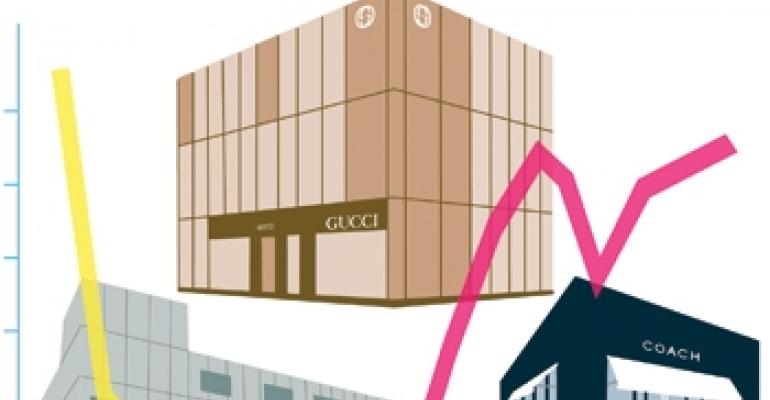
Luxury retailers might be in for a dry spell in the coming months.
The good thing is that upscale merchants have learned some lessons since the last recession and today know how to adapt quickly.
Year-to-date luxury retailers have been performing well, with luxury department stores posting same-store sales growth of 8.5 percent, ahead of 7.4 percent growth for all retail chains tracked by ICSC. Retail leasing activity on upscale urban streets like Madison Avenue in New York City has also been up this year, with more chains signing deals, according to Joshua Strauss, vice president with Robert K. Futterman & Associates, a New York City-based retail brokerage and consulting firm.
In September, rents on Fifth Avenue, currently the most expensive retail street in the world, jumped 21.6 percent year-over-year, to $2,250 per square foot, according to a report from global brokerage firm Cushman & Wakefield. Rents on Madison Avenue went up 1.9 percent to $847 per square foot. On North Michigan Avenue in Chicago rents rose 12.5 percent, to $450 per square foot.
“Retail moves a lot slower than the stock market,” says Strauss. “We haven’t seen any effect from the recent downturn.”
Yet there are indications that things might be about to change. At the end of July, the Luxury Consumption Index (LCI), tracked by Unity Marketing, a Stevens, Pa.-based market research firm, fell 16.8 points to 66.0 points, registering the biggest drop since the beginning of the recession in late 2007/early 2008. Affluent consumers see the disturbing signs in the direction of the economy and the financial markets and plan to be spending less on discretionary goods, according to Unity Marketing President Pam Danziger.
“Our surveys tend to be a little ahead of what’s going on with luxury companies and what we saw in the middle of the year was a sharp and steep decline in the confidence level of luxury consumers,” Danziger says. “These people are expressing a whole lot of concern about what’s going on and they are not going to risk their lifestyle to buy another bag or pair of shoes. That’s the kind of wave we see forming right now for the coming Christmas season.”
Security measures
While there are red flags ahead for luxury retailers, this time around they are better prepared to withstand the potential downturn than they were in the mid-2000s, according to Howard Davidowitz, chairman of Davidowitz & Associates Inc., a New York City-based retail consulting and investment banking firm.
Prior to the crash in 2007, luxury retailers had been growing their aspirational customer base—middle-class consumers who wanted to own one or two luxury items, says Matt Winn, senior managing director and U.S. Retail services leader with Cushman & Wakefield. Those aspirational consumers, however, are the first ones to go when there is any sign of trouble in the economy, since high unemployment and wild stock market swings affect them the most. So today, instead of courting those shoppers, luxury retailers have been paying more attention to their core clientele and their flagship stores in major cities, says Winn.
Even if demand for luxury goods dips, “I don’t think there will be portfolio downsizing because that happened already when luxury retailers cut back on their footprints as part of the last downturn,” says Winn.
Meanwhile, luxury chains have been ensuring they can still grow in a challenging economic environment through opening outlets. Bloomingdales opened its first outlet stores last year in New Jersey, Florida and Virginia, while Coach and Saks Off Fifth have been building up their presence in the sector. Meanwhile, Neiman Marcus has been growing its Neiman Marcus Last Call portfolio and Nordstrom its Off Nordstrom Rack division.
Luxury retailers have also been devoting more resources online, says Davidowitz.
Macy’s Inc., for example, reported that in the second quarter of the year Internet sales for its Bloomingdale’s division rose 40 percent. Being able to combine in-store, online and mobile sales efforts has helped the company achieve positive overall same-store sales growth, according to remarks made by CFO Karen Hoguet during an earnings call with analysts on Aug. 10.
Year-to-date, Macy’s posted 5.9 percent growth for both its Macy’s and Bloomingdale’s stores. Nordstrom posted growth of 6.9 percent.
Luxury chains “are not putting the money into full line luxury stores. Their money is going to online sales and outlet centers because those look like growth sectors,” says Davidowitz . “It sort of leads me to believe that they are thinking they better protect themselves; maybe the party is not here forever, and it will help them tremendously to have a growth vehicle.”

